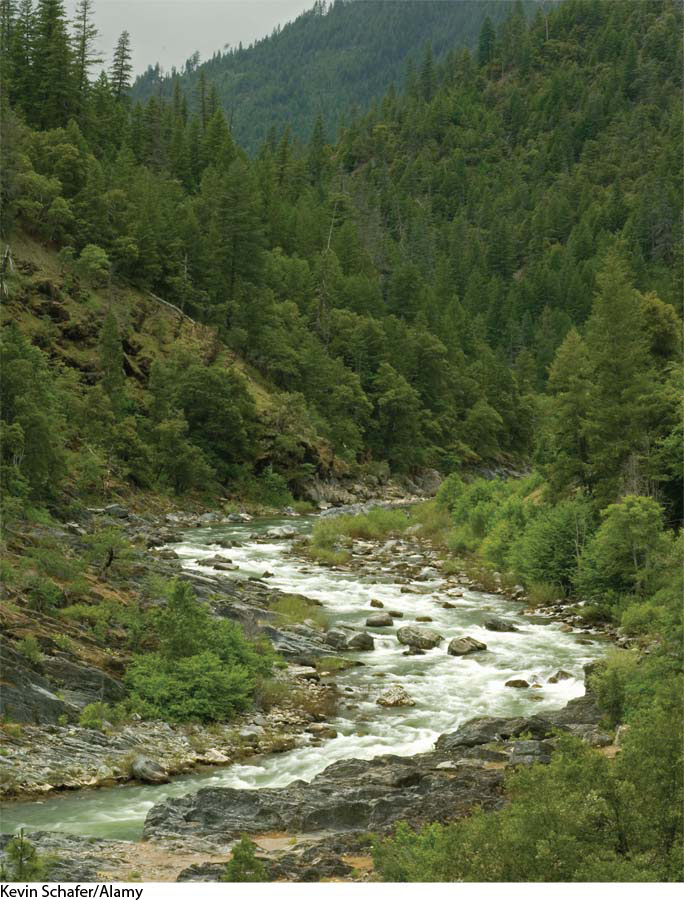Chapter Introduction
chapter 9
Water Resources

Dams and Salmon on the Klamath River
The Klamath River is a beautiful stretch of water that runs for 400 km (250 miles) from southern Oregon through northern California, where it empties into the ocean. The Klamath River was once a spectacular habitat for salmon and was the third largest salmon fishery on the West Coast. During the past 100 years, however, the Klamath River has seen many changes. It has been dammed for electricity, and farmers have settled the land and diverted water to irrigate their crops. The salmon population has been greatly reduced, and local Native American tribes and the commercial fishing industry have suffered as a result.
The Klamath River was once a spectacular habitat for salmon.
The story of the Klamath River began thousands of years ago, when six tribes of Native Americans were the sole inhabitants of the region. For more than 300 generations, these tribes relied on salmon as an important part of their diet. Historically, salmon eggs hatched in the upstream portion of the river. Young fish migrated down the river into the ocean, where they spent several years growing into mature fish. Once mature, they migrated back up the river, returning to lay eggs in the same place where they had hatched. Several species of salmon were abundant in the river. An estimated 800,000 mature chinook salmon (Oncorhynchus tshawytscha)—which can grow as large as 45 kg (100 pounds)—migrated up the river each year.
This migratory behavior worked well for thousands of years, until the region began to change during the twentieth century. In the early 1900s, the U.S. Bureau of Reclamation decided to build canals to drain two large lakes that were the source of the river. The exposed lake bottoms were turned into farmland, and the water that drained into the canals provided a constant source of irrigation for this new farmland. In addition, four hydroelectric dams were built on the river between 1908 and 1962. These dams generated enough electricity to power 70,000 homes. Because hydroelectric dams generate less pollution than other sources of electricity, these dams provided a substantial benefit to the region. But their presence imposed a barrier to the natural migration of salmon. In addition, the formation of large pools behind the dams caused a rise in water temperature that is not favorable to salmon.
As the decades passed, the multiple uses of the Klamath River began to come into conflict. In addition, a gradual warming of temperatures in the region has caused less snow to fall in the mountains. Although less snow means less water for the river, agricultural use of the river water continued, which reduced the river flow to low levels that created an additional threat to the salmon. In 1997, the coho salmon (Oncorhynchus kisutch) was given protection under the U.S. Endangered Species Act. To protect the salmon, water withdrawals could not reduce the river’s flow below the minimal level in which the salmon could thrive. That restriction prevented farmers from receiving enough water to irrigate their crops and threatened their livelihoods.
The conflict among the various interest groups intensified. Native Americans, the hydroelectric company, farmers, the commercial fishing industry, conservationists, and multiple government agencies all debated regional water management policy from different points of view.
In 2002, the migrating salmon experienced a massive die-
In 2009, the parties reached a decision. The hydroelectric company, which realized it would soon have to spend $460 million on dam renovations, agreed to remove the four dams. The farmers agreed to conserve water by planting crops that required less water and updating their irrigation technology. These changes are expected to improve river flow, thereby improving conditions for the salmon and those who depend on them. The agreement among the parties was signed in 2010 and the U.S. Interior Department supported the proposal in 2013. Once the plan is approved by Congress, the dams are scheduled to be removed by 2020 at a cost of $450 million. This endeavor represents the largest dam removal project in history. When completed, salmon will have 420 miles of uninterrupted river for the first time in a century.
Conflicts over the use of water resources are found throughout the world as human populations grow and place ever-
Sources: R. Rymer, Reuniting a river, National Geographic, December 2008, http:/
Water is a critical resource for all organisms but it can be challenging to obtain. As we saw in Chapter 4, climate variation causes some regions of the world to possess abundant supplies of water, whereas other regions have very little water. This not only affects the plants and animals that live in different regions of the world but also affects growing human populations that have limited water availability. In this chapter, we will examine the many sources of fresh water, which is the type of water that humans can drink. We will then consider how humans have developed ways of altering the availability of water on Earth. We will also examine how humans use water and the prospects for the availability of water in the future.